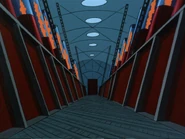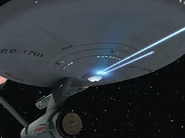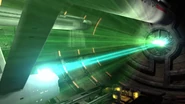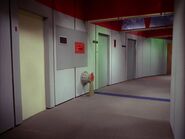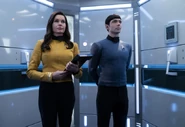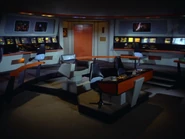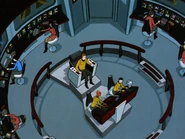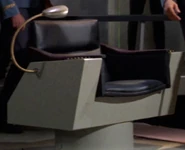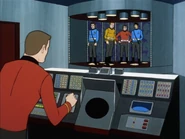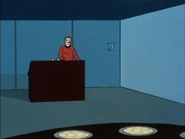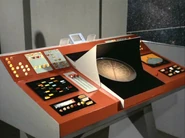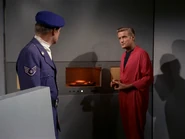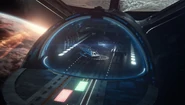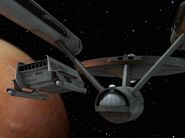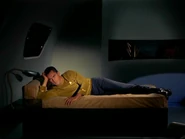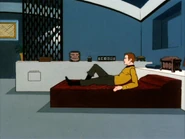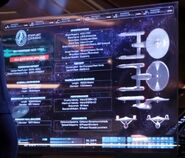The Constitution-class was a Federation Starship-class, Class I heavy cruiser that was utilized as the premier front line Starfleet vessels during the mid-23rd century.
They were designed for long duration exploration and patrol missions with minimal outside support and were best known for their celebrated missions of galactic exploration and diplomacy and were capable of operating on five-year mission cycles, with an operating endurance of eighteen years. (Star Trek: The Original Series; Star Trek: The Animated Series; Star Trek: Strange New Worlds; DIS: "Brother" display graphic)
Design[]
During the mid-23rd century, at least twelve Constitution-class starships were commissioned by Starfleet. (TOS: "Tomorrow is Yesterday") Construction of these starships occurred at Earth's San Francisco Fleet Yards, California, and Luna's Tranquility Base. (TAS: "The Counter-Clock Incident"; ENT: "In a Mirror, Darkly"; DIS: "Brother" display graphic) Many of the same unit components for the Constitution-class were also used in the construction of the related Sombra-class. (SNW: "All Those Who Wander")
The Constitution-class was generally designed for the roles of exploration, patrol, and defense. (TOS: "The Cloud Minders") Within Federation space, these vessels were viewed as having the role of protector within the civilian community. (TOS: "Mudd's Women", "The Conscience of the King", "The Trouble with Tribbles")
One of the class' original designers was Larry Marvick, whose work included designing the controls for engineering. (TOS: "Is There in Truth No Beauty?") Doctor Richard Daystrom was responsible for the basic design of the computers used aboard this class. (TOS: "The Ultimate Computer") By the 2260s, it was the assertion of Captain James T. Kirk of the USS Enterprise that his chief engineer, Lieutenant Commander Montgomery Scott "knew everything about that ship there is to know. More than the men who designed it." (TOS: "The Apple") Indeed, Scott even once bet Marvick himself that "a bottle of scotch says you can't handle the controls you designed." (TOS: "Is There in Truth No Beauty?")
In order to keep the class up to date and allow their missions of exploration to continue, the Constitution class had the ability to be outfitted with new technology, especially since the ships were sometimes on the front lines without support and needed to hold their own. (SNW: "Strange New Worlds"; TOS: "Where No Man Has Gone Before", "The Corbomite Maneuver"; Star Trek: The Motion Picture)
History[]
Launch[]
Future Enterprise captain, Robert April, was present when the ship's unit components were built. (TAS: "The Counter-Clock Incident") The ship itself was launched April 11, 2245. (DIS: "Brother" display graphic; SNW: "Strange New Worlds" Enterprise dedication plaque) In addition to the Enterprise, the USS Constellation and the USS Cayuga were also launched the same year. (PIC: "The Star Gazer" commemorative plaque, SNW: "Hegemony" display graphic)
During the conception of Star Trek, the producer's original intent was that the "Enterprise-class [sic] starships have been in existence for about forty years," according to the reference book The Making of Star Trek (p. 203). Author Stephen Whitfield, who had full access to production sources and staff (p. 12), wrote the book during the production of season two in 1967, narrowing the class launch window down to the mid-2220s, as the Original Series showrunners had placed their series exactly three-hundred years into the future from the production year of the underlying series season (p. 209).
Early 2250s[]
During the early 2250s, the Constitution-class starship, USS Enterprise, made first contact with the Talosians on Talos IV. This combined with her numerous other discoveries and achievements made her the Federation flagship. (TOS: "The Cage")
By this point the Constitution-class starships were considered Starfleet's premier vessels, as they were usually on the front lines patrolling Federation space and exploring uncharted areas just within the Federation's borders. (TOS: "The Cage"; DIS: "Will You Take My Hand?")
Around the latter half of 2254, Constitution-class vessels were outfitted with the latest technology. (TOS: "The Cage"; DIS: "Will You Take My Hand?"; SNW: "Spock Amok")

Enterprise rendezvous with the Discovery, 2257
When the Federation-Klingon War started, Constitution-class ships were kept off the front lines, as a unit of last resort. At the time, the USS Defiant was assigned to patrol Sector 006, while the USS Enterprise was ordered to continue its then five-year mission under Captain Christopher Pike. This order took a toll on their crews. During this time, with the ships out away on their five-year missions, it was rare to see a Constitution-class ship at all. (DIS: "Despite Yourself", "Brother")
During the war, the Constitution class was not Starfleet's priority to keep refitted, as Starfleet was focusing on their warships to keep the Klingons from taking Federation space, such as the Crossfield-class and its spore drive. (DIS: "Will You Take My Hand?", "Through the Valley of Shadows")
Aboard the Enterprise at least, new colorful Starfleet uniforms were adopted before some other ships. They were seen in use shortly after the Federation-Klingon War. (DIS: "Brother")
Late 2250s and early 2260s[]

The USS Enterprise, Constitution-class, circa 2259
Constitution-class starships (along with their Sombra-class counterparts) had retrofitting in 2259, updating the main AI and transporters. (DIS: "Such Sweet Sorrow, Part 2"; SNW: "Strange New Worlds")
The Constitution-class starship, the Enterprise was extensively refitted around 2265 in preparation for her first five-year mission under James T. Kirk. (TOS: "Where No Man Has Gone Before", "The Ultimate Computer")
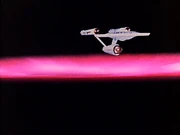
The unique configuration of the Enterprise in 2265
The USS Enterprise was the second known Federation ship to ever leave the galaxy, but sustained extensive damage in upon coming into contact with the galactic barrier. (TOS: "Where No Man Has Gone Before")
Late 2260s[]

The USS New Jersey appearing in the configuration as it appeared during the late 2260s
Following the Enterprise's return to Federation space, the ship was repaired with new equipment that was later used on other Constitution-class starships in 2266. (TOS: "Where No Man Has Gone Before", "The Corbomite Maneuver")
The year 2267, however, saw a gathering of the class when a large group was assembled at Starbase 11 for refitting and repairs. (TOS: "Court Martial")
The Constitution-class continued their exploration missions at this time, and the Enterprise went on perhaps the greatest mission to date under the command of James T Kirk, discovering and making contact with many new species. (TOS: "Where No Man Has Gone Before", "The Corbomite Maneuver", "Turnabout Intruder"; TAS: "Beyond the Farthest Star")
Despite the successes of the class, exemplified by the performance of the Enterprise, under Captain James T. Kirk, the mission parameters for the Constitution-class also meant that the vessels of the class operated under highly dangerous circumstances, resulting in a relatively high loss rate, and that being assigned to one was hazardous at best. Due to this, in the late 2260s, many Constitution-class vessels were lost. In 2267 for example, the USS Constellation under the command of Commodore Matt Decker fell victim to what has become known as the "doomsday machine" when it was on a routine survey mission near system L-374, and both the ship and crew were lost. (TOS: "The Doomsday Machine") Likewise, and less than a year later in 2268, the Vulcan-manned USS Intrepid was lost with its entire crew in a fatal encounter with a huge simple cellular being in star system Gamma 7A of Sector 39J. (TOS: "The Immunity Syndrome") Later that year, the USS Exeter became infected with an unknown virus, a residue from biological warfare which had raged on Omega IV and which the ship was orbiting, again killing her entire crew, save for its captain, Ronald Tracey. While undamaged, the contaminated ship was for the time being left adrift. (TOS: "The Omega Glory")
In late-2268, the starships Excalibur, Hood, Lexington, and Potemkin all took part in the disastrous testing of the M-5 multitronic unit, which had been placed in control of the Enterprise. The Excalibur was severely damaged, with all hands lost. The Lexington also was brutally assaulted by the M-5 computer when the unit became unstable. (TOS: "The Ultimate Computer")
Later that year, the Defiant responded to a distress call from an unexplored sector of space, claimed by the Tholian Assembly. Shortly upon entering the region, the Defiant crew began experiencing sensory distortion, and insanity quickly spread throughout the ship. The ship's surgeon was unable to determine what was happening, and eventually, the insanity induced by the phenomenon led the crew to kill each other. (TOS: "The Tholian Web")
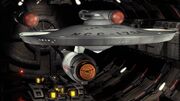
The Defiant in a Tholian drydock facility
Three weeks later, Starfleet ordered the Enterprise to mount a search mission to locate the Defiant. On stardate 5693.2, the Enterprise located her adrift, lost between universes in a space warp. As a result of a later phaser exchange between the Enterprise and two Tholian ships, a hole was created through the spatial interphase, pushing the Defiant into the mirror universe. (TOS: "The Tholian Web")
2270s refit[]
In the early 2270s, the Constitution-class underwent a massive refit and redesign which would later be known as the Constitution II-class. (Star Trek: The Motion Picture; PIC: "The Bounty")
Mirror universe[]
The Defiant emerged in the 22nd century mirror universe, where the Tholians of that universe had created the interphase rift by detonating a tricobalt warhead within the gravity well of a dead star. The Defiant was initially captured by the Tholians, but later taken over by the Terran Empire with control of the ship finally passing to Hoshi Sato. (ENT: "In a Mirror, Darkly", "In a Mirror, Darkly, Part II")

The Defiant as modified by the Terran Empire
In 2256 the USS Discovery became inadvertently trapped in the mirror universe, where its crew discovered that the Defiant had in the meantime undergone substantial modifications while it had been in the service of the Terran Empire. (DIS: "Despite Yourself") Upon her return to the prime universe however, their findings became part of all the intelligence pertaining to the USS Discovery that was sequestered by Starfleet Command as strictly classified after the ship had disappeared yet again in 2258. (DIS: "Such Sweet Sorrow, Part 2") It explained why the command crew of the USS Enterprise was not aware of Defiant's fate when it chanced upon her derelict hulk in 2268, shortly before she transited into the mirror universe, also unbeknownst to the Enterprise command crew at the time. (TOS: "The Tholian Web")
In 2267, the ISS Enterprise was a Constitution-class starship of the Imperial Starfleet identical in configuration to the prime Enterprise, as was discovered by her command crew when they too became inadvertently trapped on the mirror universe version of their ship. (TOS: "Mirror, Mirror") They were unaware of the fact that she had been based off the USS Defiant whose transition into the mirror universe they would only witness the following year, although remaining unable to connect the dots.
Legacy[]

A computer image of a Constitution class ship
In 2384, Hologram Janeway was able to holographically change the USS Protostar's control consoles to those a mid-23rd century Constitution-class starship so that the Enderprizian -- who were familiar with the consoles of the USS Enterprise from that era -- could help pilot the Protostar. (PRO: "All the World's a Stage")
An animated image of a Constitution class ship was used in Temporal Mechanics 101, as presented by Doctor Erin Macdonald of Starfleet Academy. (PRO: "Temporal Mechanics 101")
By 2401, the original Constitution-class had been completely phased out, though a few remained as training vessels. At least one Constitution-class starship retaining its original design, the USS New Jersey, was preserved in the Fleet Museum in its late 2260s configuration. (TNG: "Relics"; PIC: "The Bounty")
The time-displaced Commander Rayner from 3191 used the fact that Lieutenant Rhys's favorite kind of starship was the 23rd century Constitution-class as proof that he knew the man in the future. Rhys had told Rayner that he loved the ship's curves, something that Rayner himself agreed with. (DIS: "Face the Strange")
Technical data[]
Physical arrangement[]

Profile schematic: bridge, shuttlecraft hangar, secondary hull, main sensor, sensor array t[op]/b[ottom]

Dorsal schematic: phaser bank p/s, impulse power, space/warp propulsion 2 units, primary hull
The Constitution-class featured the saucer section-engineering section-warp nacelle layout common to most Starfleet vessels. All ship configurations of the class of the appeared to be identical at first glance, but closer inspection revealed minor detail differences on certain vessels. (TOS: "The Cage", "The Ultimate Computer"; etc.)
Various science labs, numbering fourteen in all, (TOS: "Operation -- Annihilate!") were located in the primary hull in the class' configuration in the 2260s. There were at least seven turbolifts that serviced the primary and secondary hulls. (TOS: "The Man Trap") The Constitution-class had at least two briefing rooms, one of which was located on Deck 14. (TOS: "Mudd's Women")
The modular design of the Constitution-class allowed for component separation in times of crisis. If an emergency was confined to the warp engine nacelles, it was theoretically possible to disengage and jettison the secondary hull while keeping the bulk of the vessel's main section intact. Any hull separation was considered a dangerous procedure and not always an option. (TOS: "The Apple", "The Savage Curtain")
Though not an aerodynamic craft, in emergencies, Constitution-class vessels were able to break orbit and enter a class M planet's upper atmosphere (and maintain altitude control while passing through it) for a limited period of time, conditional on the ship's ability to re-achieve escape velocity. (TOS: "Tomorrow is Yesterday"; SNW: "Strange New Worlds")
Propulsion systems[]
Warp engines[]

The Enterprise at warp
The Constitution-class of starship were lithium, and later dilithium powered warp engines that fueled a matter/antimatter propulsion system over its service lifetime. (TOS: "Where No Man Has Gone Before", "Mudd's Women"; DIS: "Brother" display graphic) Altogether this allowed the class to spec a maximum safe cruising speed of warp 6 (or 384c) and an emergency speed of warp 8 (or 512c). (TOS: "Amok Time", "Obsession"; TAS: "One of Our Planets Is Missing"; DIS: "Brother" display graphic)
During the mid-2250s the ship was more than capable of operating nominally at warp 7. (TOS: "The Cage") By the 2260s such a speed was unusual; Kirk's order of warp 7 in pursuit of an unknown ship after the destruction of Cestus III surprised the bridge crew, and both Spock and Scott advised against sustaining the speed. (TOS: "Arena")
The Enterprise infrequently reached warp 8; Kirk's order for the speed during the above pursuit alarmed Spock and Scott. (TOS: "Arena") Scott confirmed, when asked if the ship could be capable of warp 8, that he could, and offered "maybe a wee bit more," even offering to, "sit on the warp engines myself and nurse them," if needed. (TOS: "That Which Survives") While the Enterprise had once engaged at warp 9 to escape the Romulan Neutral Zone (TOS: "The Enterprise Incident"), doing so was highly discouraged because it was an unsafe velocity, as was noted following when the ship was taken over by the Beta XII-A entity. (TOS: "Day of the Dove")
With further modifications or influences, the Enterprise managed to even push beyond warp 9 on more than one occasion, once following modifications made by Lokai, it exceeded warp 10, and again achieved warp 10 when it was drawn into the creation point. (TOS: "Let That Be Your Last Battlefield"; TAS: "The Magicks of Megas-Tu")
The Enterprise was also twice modified to achieve a speed of warp 11. The first time was when the probe Nomad increased the ship's engine efficiency by 57% in 2267 and allowed the ship to reach warp 11, but Kirk persuaded Nomad to reverse its "repairs" because the ship's structure could not stand the stress of that much power, and it would eventually destroy the ship. (TOS: "The Changeling") The second time followed when more extensive modifications were made to the ship by the Kelvans in 2268, who were able to produce velocities that were far beyond the reach of Federation science, allowing the Enterprise to safely maintain a cruising speed of warp 11 while traveling through the intergalactic void. (TOS: "By Any Other Name")
The maximum warp speed recorded for this class by itself was warp 14.1, achieved by the Enterprise due to sabotage to the vessel's warp drive system. While the ship itself was not structured to take that speed for any length of time, the Enterprise was able to maintain that velocity for nearly fifteen minutes. (TOS: "That Which Survives")
The Enterprise artificially maintained stability at warp 22 while tractored to a ship going warp 32. (TAS: "The Counter-Clock Incident")
If the reserves for the antimatter engine ever dropped of the indicator below two anti-kilos, the engines would no longer regenerate. (TAS: "One of Our Planets Is Missing")
Bussard collectors[]

Bussard collectors

Bussard collector collecting deuterium
The Constitution-class was equipped with Bussard collectors at the front of the warp nacelles. The primary purpose of bussard collectors was that they could be used to collect interstellar hydrogen (deuterium) and other particles, however they could also be used to expel these gases as well. Bussard collectors were useful for when these ships passed through a hydrogen rich nebula, as it allowed them to pull in hydrogen which was the primary fuel source for the constitution class starship and their warp cores. (TOS: "The Cage", "Where No Man Has Gone Before", "The Corbomite Maneuver"; DIS: "Context Is for Kings", "Will You Take My Hand?"; SNW: "Strange New Worlds", "Lost in Translation")
Impulse engines[]

A close-up of the impulse drive assembly in 2266
The main sub light drive on Constitution-class starships was an impulse drive, located at the back of the saucer/primary hull section of the ship and was where fusion exhaust propelled the ship.
A fusion explosion equivalent to at least 97.835 megatons would result if the impulse engines were overloaded in 2267. (TOS: "The Doomsday Machine")
Tactical systems[]
While the Constitution-class was never meant as a warship, the vessel was adequately well-armed for dealing with various threats. Exercising Federation defense policy and if need be, sustained conflict was built into them. Thus, they carried an array of weapons thus allowing them to hold their own against even dedicated warships of its day. (TOS-R: "Errand of Mercy", et al.)
Directed beam batteries[]

USS Enterprise firing her main batteries

...and seen firing a single phaser
During the early 2250s, Constitution-class heavy cruisers were armed with a complement of directed energy weapons, that possessed enough power to destroy half a continent in a concentrated bombardment. In addition, these vessels carried on board laser cannons, capable of operating on energy fed remotely from the ship. (TOS: "The Cage", "The Menagerie, Part I", "The Menagerie, Part II")
Laser cannons[]
From 2254 to 2257, Constitution-class vessels were fitted with laser cannons. These were an upgrade to the phase cannons on previous ships in Starfleet, however the laser cannons were quickly replaced by phaser banks once the technology was developed. (TOS: "The Cage"; DIS: "Such Sweet Sorrow, Part 2"; SNW: "Lift Us Where Suffering Cannot Reach"; TOS: "Balance of Terror")
According to the Star Trek Spaceflight Chronology (p. 164), the advanced ship-board laser banks used by Constitution-class starships were upgraded to phaser banks four years after the Enterprise had visited Talos IV in "The Cage".
Main phasers[]
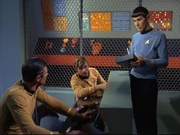
Phaser control room
With a range of approximately 90,000 kilometers, the Constition's main phasers were targeted via directional beam produced by the navigator or helmsman via a direct line of communication with phaser crews located in the phaser control room. In order to prepare the ship for firing, the main phasers needed to be energized, primed, and brought to full power. (TOS: "The Corbomite Maneuver", "Balance of Terror", "Arena") Phaser tracking controls was also used in phaser operation. (TOS: "The Tholian Web")
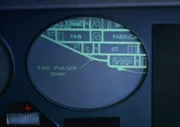
Diagram of forward phaser bank
These ship mounted phasers were capable of being adjusted to a rate as low as 1/100th power, and like hand phasers were capable of stun, heat, or disintegrate targets, including objects or beings in space or on a planet's surface. (TOS: "The Ultimate Computer", "A Piece of the Action") The focus could be adjusted from a narrow to a wide beam. (TOS: "Who Mourns for Adonais?", "Whom Gods Destroy", "The Paradise Syndrome", "A Piece of the Action") Targeting was typically done visually, but could also be accomplished on motion sensors at a loss of accuracy. When only motion sensor readings were available, the ship's phasers could be set for proximity blast or a 100% dispersal pattern. (TOS: "Balance of Terror", "Errand of Mercy")
By 2257, this class of ship had a standard complement of six phaser emitters. (DIS: "Brother" display graphic) This included placements at port, starboard, and mid-ship, among which were two to (up to) four forward phaser banks. (TOS: "Balance of Terror", "The Paradise Syndrome") There were also two banks each on the port and starboard on the dorsal surface of the primary hull. Two banks covered both flanks.(TNG: "Datalore" display graphic)
By the late 2260s, the ship also had aft banks located above and below the shuttlebay on the secondary hull. (ENT: "In a Mirror, Darkly, Part II")
Based on dialogue from "The Paradise Syndrome", there were four forward phasers, though the visual effects in that episode depict two phasers firing on each discharge, suggesting a battery of eight forward phaser emitters.
In a scene description from the final draft script of "In a Mirror, Darkly, Part II", the aft phaser was said to be "beneath the hangar deck." However, the location of the aft phaser is shown on-screen to be above the hangar deck.
Torpedo systems[]
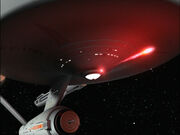
Torpedo launcher in 2267
Constitution-class ships torpedo tubes were located on the underside of the saucer section, and aft mounted capabilities at the end of the secondary hull. (TOS: "Arena"; ENT: "In a Mirror, Darkly, Part II") This combined arsenal was powerful enough to destroy the entire surface of a planet. (TOS: "A Taste of Armageddon")
The standard complement consisted of two 2 forward torpedo launchers, as well as aft torpedoes. (DIS: "Brother"; ENT: "In a Mirror, Darkly, Part II")
According to a line of dialogue from TOS: "Journey to Babel", Kirk ordered his crew to "fire photon torpedoes two, four, and six", indicating that the first three torpedoes in the "even" launcher were fired. Further dialogue in scene from TOS: "Elaan of Troyius", in which all tubes were brought to bear, the full spread of torpedoes from the forward tubes consisted of six photon torpedoes, again indicating two tubes capable of rapidly firing three torpedoes at one time.
Dialogue from TAS: "More Tribbles, More Troubles" suggests that the first tube was identified as through the command/reply: "fire one"/"one fired".
Dialogue from "A Taste of Armageddon" states that the Enterprise possessed a complement of at least "a few dozen." According to the apocryphal Star Trek Spaceflight Chronology (p. 164), in the late 2260s configuration the ship carried a total of four hundred photon torpedoes.
Defensive systems[]
The Constitution-class starship had two types of defensive systems, consisting of deflector screens and shields. The shield shield grid was divided into four segments, referred to as "number one shield", "number two shield", etc. (TOS: "Journey to Babel", "Elaan of Troyius") At full power, with the warp reactor tied into the shield system, it was capable of absorbing and repulsing a bombardment of energy impacts equal to the detonation of 360 photon torpedoes of the type the Enterprise was equipped with at the time, before the shielding power was completely lost. In 2267, for example, the Enterprise survived an attack from the Nomad probe. Nomad fired four powerful bolts of energy, each with the equivalent force of ninety photon torpedoes. The first hit reduced shielding power only by twenty percent. After being hit with the equal force of 270 photon torpedoes, warp maneuvering power was lost. Shields were lost with the fourth hit. (TOS: "The Changeling") A ship was no capable of firing full phasers with its screens up. (TOS: "A Taste of Armageddon")
The deflector shield grid was much more vulnerable to intense standard phaser bombardment. In 2268, an Orion scout ship was able to cause buckling in some of the shields of the Enterprise after it had made just five attack runs on the ship. On the seventh run, the Enterprise lost one of its four shields. (TOS: "Journey to Babel") Other more powerful weaponry could take the shields down even more easily, the planet killer for example could completely deplete a Constitution-class starship's shielding power with only three hits with its antiproton beam. (TOS: "The Doomsday Machine")
The diversion of all but emergency maintenance power to the shields had the adverse effect of reducing phaser power by fifty percent. (TOS: "The Tholian Web") A single detonation of a nuclear warhead less than a hundred meters away could cause internal overloads on the ship and leak radiation through the shields to the outer regions of the ship. (TOS: "Balance of Terror") Without the warp reactor to power the shields, the system was not very effective in protecting the ship. With only the impulse reactors powering the shields, a D7-class Klingon battle cruiser could deplete a Constitution-class starship's shielding power with only few passes of disruptor fire. (TOS: "Elaan of Troyius")
[]
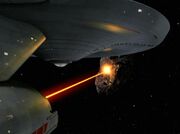
The navigational deflector dish
The navigational deflector dish on Constitution-class vessels was mounted at the front of the secondary hull. It was mainly used to deflect/repel debris and other objects.
In 2268 the USS Enterprise used a deflector beam to attempt to shift a large asteroid off course when it threatened the planet Amerind. The attempt failed and caused damage to the ship's power. (TOS: "The Paradise Syndrome")
Stephen E. Whitfield and Gene Roddenberry's The Making of Star Trek (p. 191) stated of the vessel's prominent dish: "The starship's main sensor-deflector (a parabolic sensor and asteroid-deflector) is located at the front end of the secondary hull." In accordance with this, Franz Joseph's Star Trek Blueprints labeled it as the "main sensor and navigational deflector," although Joseph's Star Fleet Technical Manual omitted the latter and referred to it only as the "main sensor." Some Matt Jefferies concept sketches of the ship had earlier included a dome-shaped nosecone "sensor" in place of, or perhaps covering, the dish. (Star Trek: The Original Series Sketchbook, p. 68; The Art of Star Trek, p. 9)
Interior design[]
The color scheme implemented aboard Constitution-class ships was predominantly red-orange accents alongside dark gray or light gray paneling. These colors were accented with soft white light or multicolored lights installed in floor and wall paneling, and later, in the ceiling. This color scheme was put in and kept from the Constitution-class refit of the mid-2250s to the early 2270s. (Star Trek: The Original Series; ENT: "In a Mirror, Darkly", "In a Mirror, Darkly, Part II"; DIS: "Brother", "Such Sweet Sorrow", "Such Sweet Sorrow, Part 2"; ST: "Q&A", "The Trouble with Edward", "Ask Not"; DS9: "Trials and Tribble-ations")
Main bridge[]
Overview[]

The translucent bridge dome
Located at deck 1 atop of the primary hull, the Constitution's main bridge directly supervised all primary mission operations and coordinated all departmental activities. Due to the age and variety of configurations of the Constitution-class, bridge configurations varied from mission to mission and ship to ship.
Multiple sets were used to represent the bridge of the original Constitution-class. In Star Trek: The Next Generation, a partial set was faithfully recreated for "Relics", a full set was created for "Trials and Tribble-ations", a new set with a slightly altered appearance was built for the two-part "In a Mirror, Darkly" and "In a Mirror, Darkly, Part II", and starting with "Such Sweet Sorrow", a completely new set, with updated design, bigger overall diameter, and a blend of touchscreen and classic jelly bean controls was introduced.
Command chair[]
The command chair was located in the recessed area at the center of the room, where consequently, the captain could be immediately updated on the condition of the vessel or its crew during missions, and orders could be given clearly with a minimum of effort. The chair was mounted on a circular pillar, attached to a rectangular footplate that was directly anchored to the deck. It was designed to swivel on the support so that the captain could turn to any member of the bridge crew.
The command chairs featured three slightly different versions of the same command chair. Most, such as the one on the USS Enterprise, featured a backrest that only reached the mid-back. The 2250s and 2260s version of this chair had a "gooseneck viewer" on the right armrest. (TOS: "The Cage", "Where No Man Has Gone Before") A few, such as that of the USS Lexington, had a full backrest. (TOS: "The Ultimate Computer")
The full backrest used for the Lexington helped visually distinguish between the bridges of that ship and the Enterprise. The same full backrest was used on the set re-dress of the bridge for the mirror universe ISS Enterprise in the episode TOS: "Mirror, Mirror".
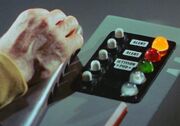
The captain's chair controls
The command chair also had buttons on either of the arm rests used to operate the command console. The left side contained the button for companel, and the right side contained buttons for manually placing the ship on red or yellow alert, as well as one to jettison pod. (TOS: "Court Martial") The gooseneck viewer was eliminated by 2266, but the other console controls remained. (TOS: "The Corbomite Maneuver")
Bridge stations[]
The command chair was position was equidistant from all the control consoles that operated specific bridge stations.
Piloting and navigation functions were carried out at the helm console, located in the center of the room, positioned in front of the command chair. This panel consisted of three main sections.
On the left was a compartment which opened automatically to permit operation of the targeting scanner. Next to this was the main control panel, which operated maneuvering thrusters, impulse engines, and fired the ship's weapons. Directly below this panel was a row of eight flip-switches provided to set warp flight speeds.
The central section of the conn panel was fitted with a number of sensor monitor lights and was dominated by two main features: the alert indicator and the astrogator, which was used for long-range course plotting. The navigation console had a control panel for entering the course and heading data and the flight path indicator and supplied information on any deviations or course corrections in progress. It also had controls for the weapons systems.

A duotronic-based data-input bridge console
Other stations on the bridge were provided for communications station, engineering station, weapons control, gravity control, damage control, environmental engineering, science and library computer, and internal security. (TOS: "This Side of Paradise", "The Ultimate Computer", et al.) All computer systems aboard the Constitution-class were duotronic-based. (TOS: "The Ultimate Computer"; DS9: "Trials and Tribble-ations") During the mid-2260s, these consoles were 203-R compatible. (TOS: "Where No Man Has Gone Before")
Additional features[]

The viewscreen aboard the USS Enterprise in 2259
Mounted into the room's forward bulkhead was the main viewscreen. Visual sensor pickups located at various points on the Constitution-class' outer hull were capable of image magnification and allowed a varied choice of viewing angles. (TOS: "The Corbomite Maneuver", "Balance of Terror", et al.)
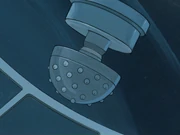
The automatic bridge defense system deployed
In the late 2260s, along with the added turbolift, the bridge design changed from a segmented flat-panel peripheral station configuration to a completely circular design, including curved overhead viewscreens, and railings and steps which matched the arc of the circumference. At the same time, an automatic bridge defense system was also installed atop the ceiling. (TAS: "Beyond the Farthest Star")
According to production designer Matt Jefferies, dramatic necessity required the turbolift to be moved from its planned center-line position (as seen on the Enterprise model). This offset placement allowed characters to walk onto the bridge and enter scenes without being blocked by actors sitting in the command chair.
Main engineering[]
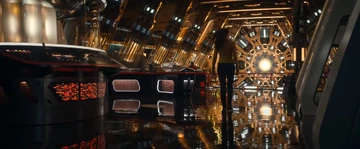
| |
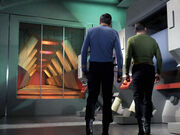
|

|

|
|
Main engineering was from where the ship's warp was controlled. All thrust and power systems were primarily controlled from this site, and it is also where the main dilithium crystal reactor/warp core was located for most of the ship's life. Life support was controlled separately from Deck 6. (TOS: "The Ultimate Computer", "The Corbomite Maneuver", "The Naked Time", "The Enemy Within", "The Conscience of the King", "Day of the Dove")
In 2259, the warp core was located in main engineering. The matter and antimatter were directed down into the reaction chamber where the dilithium crystals were and then the resulting electro-plasma was directed through unseen conduits into the warp conduits on the walls in the back of the engineering room to the warp nacelles. (SNW: "Strange New Worlds", "Ghosts of Illyria")
In 2266, the warp core was moved to a separate room called the dilithium crystal energizer room, where the main warp reaction occurred horizontally. The warp plasma conduits to the nacelles remained in main engineering but were secured being a grate. (TOS: "The Alternative Factor") In 2268, the warp core was moved back to Engineering, with the dilithium crystals and main reaction occurring in a dilithium crystal converter. The matter anti-matter reaction still happened horizontally at this time and was still directed into unseen conduits beneath the engineering deck. In late 2269, a new vertical component of the warp core was added to the dilithium crystal converter. (TAS: "The Terratin Incident")
Transporter rooms[]
Extravehicular transporter to and from the ship could be accomplished by a number of transporter systems besides the airlocks, which allowed personnel or equipment to be transported over large ranges. The transporter platform featured six small pads, which were numbered clockwise, beginning with the right front. (SNW: "Strange New Worlds", TOS: "The Cage", "Where No Man Has Gone Before") A large section in the middle of the transporter could be used to transport large cargo. (TOS: "Dagger of the Mind")
A door in the standard transporter room wall led to a staging area where landing parties prepared for transporter. (TOS: "The Cage")
The transporter room was also outfitted with a food slot. (TOS: "Tomorrow is Yesterday")
Landing bay and cargo facilities[]
The aft landing bay provided personnel in small craft with a means of entering or exiting the vessel.
The 2260s configuration of the Constitution-class carried a standard complement of 4 shuttlecraft, some of which were Class F. (TOS: "The Omega Glory")
The class contained at least five cargo holds. (TAS: "Beyond the Farthest Star")
This may have varied per ship, as while the USS Exeter was specifically stated to just have four, the USS Enterprise was seen with one Class F and three other shuttles in its shuttlebay in TAS: "Mudd's Passion". The same ship was also seen to have at least two Class F shuttles earlier in TOS: "The Galileo Seven", so its shuttle configuration may have varied over time as well.
Sickbay[]

Constitution-class sickbay in 2259

Biobeds in sickbay
On the Constitution-class starships in the late 2260s, a sickbay facility was located on Deck 6, which featured an examination room, a nursery, the chief medical officer's office and a medical lab. At least one other medical lab was located elsewhere on the vessel, and was used for biopsy, among other things. Sickbay was considered the safest place to be on the ship during combat. (TOS: "The Naked Time", "Elaan of Troyius") Many of the tools used in the Sickbay aboard the USS Enterprise, following her launch, were designed by her first medical officer, Doctor Sarah April, as life aboard required frequent improvisation. (TAS: "The Counter-Clock Incident")
The sickbay set of the pilot episode "Where No Man Has Gone Before" underwent considerable changes following the shooting of the episode for the remainder of the series.
Crew lounge and recreation facilities[]
The crew/officers lounge on Constitution-class starships offered an officers' lounge, adored by multiple viewpoints and with tables and a seating area.
In the late 2260s, the crew lounge was located at the front of the saucer section, just above the three windows below it. (SNW: "Strange New Worlds")
In the late 2260s, there were at least six recreation rooms, which included three-dimensional chess and card game tables. There was also a holographic rec room, which was the predecessor of the holodeck. Also aboard were an arboretum, galley, gymnasium, a bowling alley, a theater, and a chapel. (TOS: "Charlie X", "The Naked Time", "The Conscience of the King", "Is There in Truth No Beauty?")
Crew quarters[]
Crew quarters were located throughout the saucer section – keeping with Starfleet tradition, Deck 5 housed the senior officers' quarters.
From the 2250s to at least 2265, officers' quarters on a Constitution-class were larger than in latter half of the 2260s and later due to an increase in a Constitution-class' crew compliment size from 203 to 450. (TOS: "The Cage"; DIS: "Brother", "Such Sweet Sorrow, Part 2"; SNW: "Strange New Worlds", "Children of the Comet", "Spock Amok"; TOS: "The Enemy Within")
In "The Cage", Pike claims to be responsible for 203 lives. In "Brother", set three years later, scans still show 203 crew members, which was explicitly called the vessel's "entire complement." This crew count originated from Gene Roddenberry's original March 1964 Star Trek is... pitch (p. 9), whereas he had revised the number upwards to 430, "approximately one-third of them female", in the 17 April 1967 third draft of the series' "The Writer's Bible", aka The Star Trek Guide (p. 7).
The number of personnel assigned to the ship, as noted in numerous TOS episodes, including "The Ultimate Computer", which was set a decade later, establihsed a crew compliment of 430. This number was later adopted by Franz Joseph for his 1975 Technical Manual, whose "Class I Heavy Cruiser – Constitution Class Starships" specifications in turn became the source a display graphic that was erroneously featured in "Brother", stating the larger crew size found under Kirk's command, specifically a crew compliment of 430 (43 officers, 387 enlisted).
For most of a Constitution-class starship's life, the officers' quarters featured two areas, separated partly by a wall fragment. One area was allocated as sleeping area, featuring a comfortable bed, and another as work area, including a desk and computer terminal. Entrance to a bathroom was provided through the quarter's sleeping area. Both areas could be configured to personal preference. (ENT: "In a Mirror, Darkly, Part II"; TOS: "The Enemy Within")
On the original series, several "different" crew quarters were seen, but always the same set was used, changed by different lighting designs and furniture configuration.
Ships in class[]
- Named3
- Unnamed
- Mirror Universe
- Alternate
- Fictional
- Uncertain
- Unnamed
Appendices[]
Appearances[]
The Constitution-class Enterprise appeared in every episode of SNW, TOS, and TAS (except for "The Slaver Weapon"). Episodes featuring other Constitution-class vessels, or the Enterprise for other series, are listed below.
- TOS:
- "Court Martial" (remastered only)
- "The Doomsday Machine"
- "The Ultimate Computer"
- "The Omega Glory"
- "The Tholian Web"
- Star Trek films:
- Star Trek: The Motion Picture (painting)
- Star Trek II: The Wrath of Khan (display graphic)
- Star Trek III: The Search for Spock (display graphic)
- Star Trek IV: The Voyage Home (display graphic)
- Star Trek Generations (painting)
- Star Trek: First Contact (model)
- Star Trek Nemesis (model)
- TNG:
- "The Naked Now" (display graphic)
- "Haven" (model)
- "Datalore" (display graphic)
- "Booby Trap" (model)
- "The First Duty" (model)
- "Relics" (holographic recreation of bridge)
- DS9:
- "The Nagus" (display graphic)
- "Trials and Tribble-ations"
- "What You Leave Behind" (corridor in montage scene)
- VOY: "In the Flesh" (wall display)
- ENT:
- "In a Mirror, Darkly"
- "In a Mirror, Darkly, Part II"
- "These Are the Voyages..." (archive footage)
- DIS:
- "Despite Yourself" (display graphic)
- "Will You Take My Hand?"
- "Brother"
- "If Memory Serves" (archive footage)
- "Such Sweet Sorrow"
- "Such Sweet Sorrow, Part 2"
- ST: "Ephraim and Dot"
- PIC:
- "Maps and Legends" (hologram)
- "The Star Gazer" (display graphic)
- "The Bounty"
- "Vox"
- "The Last Generation"
- LD:
- "An Embarrassment Of Dooplers" (photograph)
- "Crisis Point 2: Paradoxus" (display graphic)
- PRO:
- "Starstruck" (hologram)
- "All the World's a Stage" (stageplay backdrop; holographic recreation of consoles)
- SNW:
- "Spock Amok"
- "A Quality of Mercy"
- "Among the Lotus Eaters"
- "Subspace Rhapsody" (interior only)
- "Hegemony"
Background information[]
Name []
For information on the origin of the Constitution-class designation, please see Starship-class.
Interiors[]
- See: Constitution-class sets.
Size []
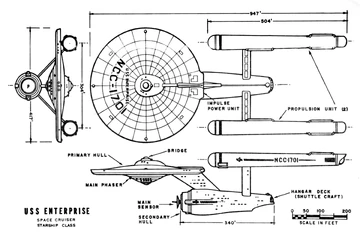
| |
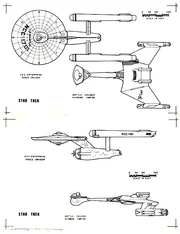
|
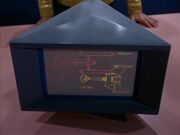 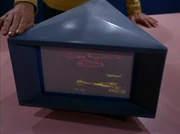
|
The length of the Constitution-class had for over half a century been accepted as being 947 feet (289 meters) long, a figure once propagated across nearly all contemporaneous reference works dealing with the subject, beginning with Stephen Edward Poe's reference book, The Making of Star Trek, p. 178. The origin of the graphic used was designer Matt Jefferies, who had originally produced the graphic in 1967 not for the actual Original Series production, but as a reference for Poe's employer, model kit company Aluminum Metal Toys (AMT) for their 1968 second edition retooled USS Enterprise model kit, No. S951 – where the graphic was displayed on the side of the box. Prior to this, a specific length for the starship had not been solidly defined as producer Gene Roddenberry's memo of 24 August 1964 evidenced, "We anticipate a final design might see the ship as 200 feet in length, and thus even a 1½-inch scale would give us quite a huge miniature." This early estimate, initially accompanied with an intended crew complement of 203, would more or less stand until Jefferies utilized his engineering background to recalculate the figures for his design three years later (The Making of Star Trek, pp. 89, 134).
The first brief onscreen indication of scale occurred when two ship size comparison graphics were featured in the Original Series third season episode "The Enterprise Incident". The two computer console graphics, also created by Jefferies, showed a Constitution-class vessel in comparison with the D7-class, along with a barely discernible yardstick. Careful measurement of the production art using that yardstick produces a figure close to but not entirely congruent with other sources, placing the Constitution-class vessel as depicted here at 900 feet (274 meters). Jefferies later sold this original art, including that created for AMT, in the Profiles in History The Star Trek Auction of 12 December 2001, in order to raise funding for the Motion Picture & Television Fund charity.
With the return of the class to the limelight as redesigned for its Star Trek: Discovery and Star Trek: Strange New Worlds appearances, a new set of specific dimensions were established onscreen in a recurring manner for the first time. Most easily seen during SNW: "Memento Mori", a length of 442 meters (1450 feet), width of 201 meters, and height of 93 meters can be identified on the dedication plaque of the Constitution-class USS Enterprise as it was in 2259. Of the 53% increase from the prior reference material figures, Discovery Production Designer Tamara Deverell said following its debut, "Overall, I think we expanded the length of it to be within the world of our Discovery, which is bigger, so we did cheat it as a larger ship." [2] In the redesign's debut episode "Brother", Deverall intended to leave behind what she called an "Easter egg for the fans" in the form of a USS Discovery bridge display screen which stated the prior reference dimensions of 288.6 meters long, 127.1 meters wide, and 72.6 meters high, taken from Franz Joseph's Star Fleet Technical Manual. A full view establishing shot of the complete graphic on a freestanding bridge monitor screen, featuring these figures, was filmed but eventually trimmed from the episode as aired. However, the graphic remained partially visible on two other Discovery bridge station computer screens; Joann Owosekun's ops station and Paul Stamets' engineering station, [3] legible in the latter case.

The Constitution-class USS Cayuga
The revised class dimensions continue to be referenced in later appearances, such as in SNW: "All Those Who Wander" on a graphic for the Sombra-class derivative, which used the same space frame as the Constitution. On 12 August 2023, the database graphic appearing in SNW: "Hegemony" for the USS Cayuga was posted with clarity by Motion Graphics Designer Tim Peel on his Twitter account, establishing that Constitution-class ship as being 442 meters long, 192 meters wide and 93 meters high. [4] A length of 442.06 meters for the USS Enterprise was cited within the Eaglemoss Collections reference publications as well.
Ships of the class []
After the first season had concluded its run, it dawned upon Original Series producers Robert H. Justman and D.C. Fontana that a need had arisen to keep track of the already mentioned Constitution-class starships for future production reference. After some corresponding with suggestions to and fro, a definitive name list of vessels belonging to the, then still called Starship-class, was agreed upon by the producers (dutifully carried over to the decal sheet of AMT's 1968 re-issue USS Enterprise model kit) at the start of the series' second season, and comprised the following vessels (The Making of Star Trek, pp. 163-165),
|
|
|
- ↑ Aside from the remarks behind several of the names, Fontana further annotated on her memo, "Alternates include the names of some famous fighting ships of the past, plus a couple of international variations we might consider, Star Fleet being composed of a united service."
- ↑ Justman noted in his memo, "I think there would be several other candidates, such as Saratoga and perhaps another English carrier, a French carrier, a Russian carrier and certainly a Japanese carrier [note: though the ultimately chosen Kongo was in reality a World War I and II -era Japanese battleship, as were the British HMS Hood and Russian Potemkin, whereas, with the exception of the Excalibur and the Endeavor, all other by Justman proposed names were those of World War II aircraft carriers, the Constellation being an at the time recent US post-war carrier]. In addition, I think a name ought to be made up that would be of Vulcan origin [note: though not adopted, some of Justman's notion was carried over to having the Intrepid a crew that was almost entirely composed of Vulcans]."
- ↑ 3.0 3.1 Remarkably, the vessel nearly made the final cut as it was already referenced to in first script draft dialogue treatment, dated 30 September 1967, page 64, for the second season episode "Journey to Babel", which contained a line having Lieutenant Uhura state, "Starfleet Command confirms alien attack on the other starships, sir. The enemy was defeated. Starships Essex and Eagle suffered heavy damage, but will make base." The reference to the Essex and the Eagle though, was dropped from the episode as aired, indicating that it was not until after September 1967 that the final list was composed. [1] USS Eagle however, resurfaced as a Constitution II-class vessel a quarter of a century later in Star Trek VI: The Undiscovered Country, referenced on the "Operation Retrieve" briefing charts, courtesy of Michael Okuda.
- ↑ 4.0 4.1 The Constitution and Kongo were the only vessels on the final list that have not been referenced to in any form or format in the Original/Animated Series beyond their inclusion on the list and, obviously, besides the class designation itself. However, a "NCC-1700" registry, presumed to be Constitution's as the class vessel by fanon ever since (most conspicuously by Gregory Jein in his influential "The Case of Jonathan Doe Starship" article), had been referenced in the prior episode "Court Martial", but the name/registry combination has never been established in canon.
- ↑ It was until 2022 generally assumed by both production staff and reference book authors alike (Michael Okuda among them in all editions of his Star Trek Encyclopedia) that Farragut was a class member. That notion became ultimately dispelled in canon in 2022 when the Farragut-type USS Farragut was shown as belonging to an altogether different starship class in the Star Trek: Strange New Worlds first season episode "A Quality of Mercy". Incidentally, after having been featured in later Star Trek live-action productions, the Cayuga, Defiant and New Jersey became subsequent confirmed class additions in canon, as was NCC-1700 for that matter – albeit without a corresponding name in the latter case.
Saucer separation[]
A saucer separation capability for the Constitution-class was suggested as early as the second season of the Original Series in the original script of its episode "The Apple", but was never produced as no Original Series script has ever actually called for one. The capability was however envisioned by the producers, "Designed to operate separately from the rest of the ship, the saucer therefore contains all elements necessary for independent operation." (The Making of Star Trek, p. 171) The intent made it even into the official series' internal writer's guide, The Star Trek Guide (third revision, page 15 of the supplement and generally dubbed the "Writer's Bible"), where the saucer section was described to be "in fact a completely self-sustaining unit which can detach itself from the galaxy drive units and operate on atomic impulse power for short range solar system exploration." [5]
Retconned design[]

The Constitution-class as it appears in TOS-R "The Cage"
There have been three different renditions of the original design:
The first model, used in the original pilot "The Cage", featured a larger bridge dome and sensor/deflector dish, and spikes on the Bussard collectors, among other minor differences. The second configuration, used in the second pilot, and throughout the rest of the series due to footage being reused, was similar to the first version, with the addition of running lights, additional markings, and a grille pattern on the rear of each engine nacelle.

The Constitution-class as it appears in TOS-R
The version used for the production of the regular series had a smaller bridge dome, a smaller sensor/deflector dish, and lighting effects in the Bussard collectors, which had their antenna spikes removed. The remastered edition of TOS replaced the anomalous stock shots in later episodes with the proper configuration.

The Constitution-class as it appears in DIS
A new, more radically redesigned model for the Constitution-class USS Enterprise was introduced in "Will You Take My Hand?". After briefly considering a radical departure from previous depictions, the designers of this new model instead aimed "to get as close as possible to the original", yet add "the sleek, unique Discovery look to it." While Discovery used this new model for all "current" depictions of the class, the "previously on" opening sequence of the Discovery episode "If Memory Serves" however, utilized an original shot of the Original Series version (instead of the actual pilot version) for the events of "The Cage" and not the newly redesigned one. A holographic image of the Discovery version of the Enterprise was later featured in the Star Trek: Picard episode "Maps and Legends" as well.
The Enterprise was redesigned for Star Trek: Discovery to look more up to date for a modern television audience. The designers first increased the size of the ship to better match with the Discovery so it wouldn't look too small. The team then began redesigning by drawing ten sketches of the ship to show how the ship could be altered. The final product was an Enterprise that fitted with the new aesthetic of Discovery, but kept close to the original.
The two Star Trek veteran re-designers of the new Enterprise, John Eaves and Scott Schneider, theorized that their new Enterprise could be refitted to become the original, as they had designed the new ship to look less advanced than the TOS series production version from the 1960s. [6]
While the Discovery series itself has shied away from explaining in canon the in-universe visual configuration differences of Enterprise between "The Cage" and the Original Series, an attempt was made to do so in the 2019 officially licensed in-universe reference book Star Trek: The USS Enterprise NCC-1701 & 1701-A Illustrated Handbook, where it followed the reasoning of the two co-redesigners by implying that the upgrades were a temporary measure to meet the crisis situation if the ship was called upon to perform as a "last resort" in the Federation-Klingon War. Page 34 had it stated that "[m]any of the Enterprise's systems had been augmented and enhanced for the mission, to ensure the ship was capable of withstanding any exceptional and extreme conditions in the extreme regions it was exploring," continuing to explain the alterations. Page 54 further implied – rather implausibly, as Kirk's mission was every bit as "exceptional" and "extreme" as Pike's had been – that these alterations were no longer deemed necessary for the subsequent five-year mission under Kirk, and that the ship was therefore returned to the "The Cage"-era configuration, though some upgrades under Pike were "retained", which included the dispensing with of the "spikes" on the Bussard collector caps and the smaller deflector dish.
Shortly before its introduction in the season one closing episode "Will You Take My Hand?" though, Executive Producer Alex Kurtzman implied that, despite the canon appearances of the classic design in both DIS: "Despite Yourself", "If Memory Serves" (albeit as a mirror universe adapted wireframe graphic only in the former case), the redesigned Constitution-class was henceforth the canonnical one and therefore intended as the definitive replacement of Matt Jefferies' classic design
Obviously [Discovery] looks more modern than The Original Series, because we are in a modern world now and if we made the show look that way people would not feel that it was worth the money. That being said, every prop and costume design is filtered through what existed at the time. And do we create the new version of it or do we augment the original design in very subtle ways or do we just leave it alone? And when I say every prop and design choice I mean every [note: "every" emphasized] prop and design choice. So, I think you will see a lot of tips of the hat to devices to The Original Series and the timeline. But, obviously we wanted to create a more modern experience and that necessitated certain adjustments. [7]

Kirk's retconned ship in "Ephraim and Dot"
Pursuant the introduction Production Designer Tamara Deverell has added more specifically, "For the Enterprise, we based it initially off of The Original Series. We were really drawing a lot of our materials from that. And then we particularly went to more of the Star Trek movies, which is a little bit fatter, a little bit bigger. Overall, I think we expanded the length of it to be within the world of our Discovery, which is bigger, so we did cheat it as a larger ship." [8] The showrunner's implied intent had already accrued credence when the redesign appeared as Kirk's Original Series ship in the Star Trek: Short Treks episode "Ephraim and Dot" shortly before its holographic reappearance, for all intent and purposes the first actual retconning of the ship in canon – which, incidentally, was all the more remarkable as the interiors shown in that episode adhered more closely to the ones as seen in The Original Series.
When redesigning the Enterprise for Strange New Worlds, the designers overhauled the windows on the saucer section because at the end of Star Trek: Discovery the front of the saucer section had been destroyed during the battle against Control. The overall majority of the model was kept the same, though the bridge window was reduced in size to not be so big and exposed. [9]
Yet, it were the season three showrunners of Star Trek: Picard, staunch Original Series fans to a man, who rendered moot whatever intentions there might have been, if any, for the classic Original Series Jefferies design, by visually inserting it into the episodes PIC: "The Bounty", "Võx", "The Last Generation" in the guise of USS New Jersey. By doing so, they effectively validated the theory retcon designers Eaves (who had worked in a similar capacity on Picard as well) and Schneider had put forward four years earlier.
Studio models[]
For further information on both original, and retcon redesign Constitution-class studio models, please see respectively,
Apocrypha[]

Joseph's alternatives for the 14 Original Series "Connies"
Although not considered canon, several sources have produced a long list of Constitution-class starships. The main source was Franz Joseph's aforementioned Star Fleet Technical Manual, which listed over one hundred Constitution-class ships divided into subclasses: Constitution, Bonhomme Richard, Achernar, and Tikopai. Ships of the class were later expanded by other publications such as Ships of the Star Fleet which included the Endeavour, Enterprise, and Enterprise (II) subclasses. It should be noted that Joseph incorporated all the ship names the Original Series producers had originally proposed at the start of the second season, and had only these listed in his Star Trek Blueprints companion publication.
Constitution-class vessels are prominently featured in fan film productions like Star Trek: Phase II, Starship Exeter (where the USS Kongo has actually performed a saucer separation in its second episode), Starship Farragut, and Of Gods and Men.
External links[]
- Constitution-class at Memory Beta, the wiki for licensed Star Trek works
- Constitution-class at Wikipedia
- Designing the First Enterprise at Forgotten Trek – article on Matt Jefferies' design of the Enterprise for The Original Series
- Designing the Starship Enterprise at the Federation Starship Datalink
- Where are the Jefferies Tubes? at Ex Astris Scientia
Original featured revision (62803) • Diff to current • Last featured revision (2161540) • Diff to current • Blurb


